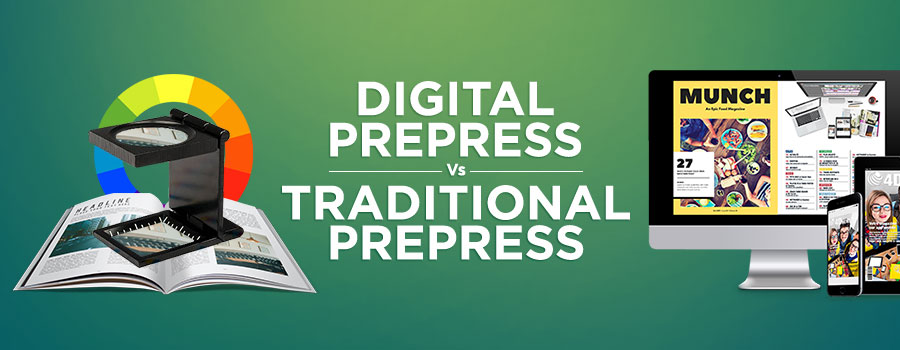Prepress is used to refer the process of getting a document ready for printing. Though the process is referred to as prepress in all the types of printing, it can hugely vary from one another, depending upon the method of printing and intricacy of the document undergoing the process. Before initiating a comparison of both, let us go through the basics.
The advances brought about by technology have considerably changed the landscape of prepress in the last two decades.

Importance
When a document needs to be printed, the designer takes the necessary steps involving the requisite incorporation and manipulation of fonts, images, colors and various other design attributes. Also, the designer would make sure that each of such attribute is able to make the document match his vision. Even though the design process is over, the copy cannot go to printing without prepress. Prepress is where the designer studies, analyses and takes the necessary steps to ensure the final print will turn out matching the one in the designer’s vision.
The transformation to digital from traditional prepress
When looking at the history of the transformation, one could argue that it wasn’t an abrupt change in the publishing industry; the change did not begin as soon as desktop publishing made its arrival in the mid 1980s. However, as the rapid advances in technology made digital desktop publishing more reliable, effective and inexpensive, the traditional prepress quickly faded to become a thing of the past.
Today in digital printing, unlike the bygone days—where a company needed to work extensively with the help of many professionally skilled staffs—one single person can do most of the tasks using various tools and software programs and with the help of a computer.
Differences between digital and traditional prepress
Design
When it comes to designing, digital and traditional prepress do not hold much of a difference between them. However, what differs significantly is the technology used to design various aspects such as the layout, images, color patterns and other printing characteristics of the documents. The conceptualization may be done by a team and the rest of the design process is carried out by the designer. However, one advantage of digital prepress is that it is easier to have multiple versions of the same with relative ease.
Typesetter
In traditional prepress, the input – text and type specifications are provided to the typesetter by the designer and the type and other various elements are put on the paste-up board by the concerned paste-up person.
On the other hand in case of digital, the roles of paste-up board, paste-up person and typesetter are taken over by the designer who has control over all tasks to be performed. Here the designer becomes the single-most authority in playing with various styles, formats and designs aspects as he pleases. Companies offering digital prepress and typesetting services therefore house the best designers.
Images
In traditional prepress, traditional photography methods and techniques are used to capture, edit, crop and enlarge or shrink photographs that are to be used. The position of the image on the layout is indicated by placing FPO boxes on the paste-up board.
Whereas in digital prepress, a modern image editing tool is used by a designer to carry out all the processes related to image editing. Once the image is edited to the desired form, it can be placed directly into the publication. This is one of the main differences between traditional and digital prepress.
File Preparation
When coming to file preparation in traditional prepress, the paste-up board is created with all the information needed and a photograph is taken of the same. The negative of the photograph is then generated by a stripper and arranged them onto a flat or sheet. The flats thus created are used for creating plates, and plates to final publication.
However in digital prepress, the designer places all the content in the publication and prints a copy which is ‘camera ready’. All other activities are carried out with the help of software programs for ease and improved effectiveness.
Proofing
When it comes to the application of prepress, proofing is something pivotal. With the traditional prepress, proofing was the most time consuming process as each error needs to be manually identified and corrected and the, new plates are printed after all the errors are eliminated.
In digital, as many copies as needed can be produced before printing the final copy and error can be easily eliminated before it reaches publication stage.
Printing
The various printing processes involved in traditional prepress are;
- Paste-up process
- Film
- Flats creation
- Plates, and
- Final printing
On the other hand in digital prepress, along with the above mentioned processes, direct output may be processed.
Once can easily see why digital prepress has become very popular in desktop publishing. Without any arguments, it can be concluded that with many more technological advances on the horizon, it is surely the way ahead. Owing to the same there are a lot of companies indulged in availing digital prepress services professionally. You can contact the best among them to be assured of amazing results.
